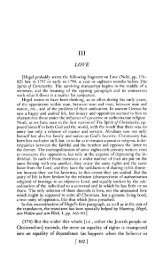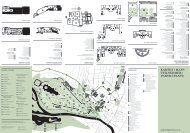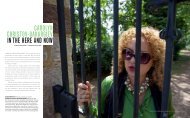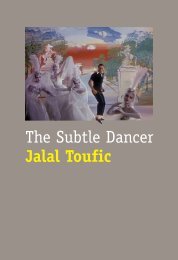A Conversation between Anna Maria Maiolino and Helena Tatay
A Conversation between Anna Maria Maiolino and Helena Tatay
A Conversation between Anna Maria Maiolino and Helena Tatay
- No tags were found...
You also want an ePaper? Increase the reach of your titles
YUMPU automatically turns print PDFs into web optimized ePapers that Google loves.
carrying many childhood traumas, because I lived through the war <strong>and</strong> post-war years. I was theyoungest of ten brothers <strong>and</strong> sisters, in a southern Italian family, <strong>and</strong>, as I’ve already said in mywritings, I was often forgotten in the middle of an air raid. As a child, I’d stay motionless in a cornerof the house for hours. Would I be able to escape such a harsh reality? Carmela, my nana, when shesaw me in that absentminded state, would call me lovingly <strong>and</strong> I would have to ab<strong>and</strong>on, halfheartedly,that secret place in my mind. Then I would find it difficult to go back; for me living was aconflict, even as a child. It was all very enriching <strong>and</strong> terrible at the same time.17): Your condition as an immigrant must have affected you, too. You changed countriesseveral times, <strong>and</strong> every time you had to adapt to different languages <strong>and</strong> situations. Catherinede Zegher, in Vida Afora/A Life Line, talks about the divided personality of the immigrant. Isthis duality, this split, cultural or to do with personality?Both, I think. In any case, they’re both reflections of my subconscious. One, to do with the duality ofthe memory of my childhood culture, which I still consider real, as it was described by NormanDouglas in his book Vecchia Calabria. 7 The other is to do with a divided identity, the feeling of beinga nomad, a pilgrim, of never being able to find a place where one can identify oneself <strong>and</strong> becomplete, as Catherine de Zegher explains. That’s why the search for language was also a healingprocess for me. Art allowed me to place my feelings, which were invisible, in the world, <strong>and</strong> totransform this ‘lack’ into compensation through a constant process of elaboration of signs <strong>and</strong>metaphors. On the other h<strong>and</strong>, my subconscious visibly legitimised my duality as it really was:natural. This is very clear in the wood engraving ANNA.18): Can you talk about the duality of ANNA?ANNA is a self-portrait in the form of a palindrome. A self-portrait where my name is substituted formy image. It’s an engraving with sharp contrasts, with opposites: black <strong>and</strong> white, positive <strong>and</strong>negative. Two white figures, father <strong>and</strong> mother, pronounce in unison the name ANNA with their bigmouths. The word ANNA is a palindrome, it can be read left to right <strong>and</strong> right to left. The two figures,in the manner of primitive idols, sit from the waist up on a rectangular block resembling a tombstone,a sepulchre, where the name ANNA is also written. The word ANNA can mean the announcement ofa birth, or a cry of sorrow for the death of the loved one. Therefore, ANNA means birth <strong>and</strong> death. Itmeans presence but also absence. Black <strong>and</strong> white. Positive <strong>and</strong> negative. Father <strong>and</strong> mother,masculine <strong>and</strong> feminine. It is a self-representation with a heavy subjective charge, where manytensions converge. This was the last figurative work I made before leaving for New York in 1968.19): Curiously, in 1968, the year when you were granted Brazilian nationality, you moved toNew York.I went to New York because my husb<strong>and</strong> had a grant. It was an important place for art at that time,there was Pop <strong>and</strong> Conceptual art was just beginning, a parallel situation to that in Brazil. There weremany Latin American artists living there, <strong>and</strong> most of them were self-exiles, not because we werebeing persecuted by the dictatorships, but because it was very difficult to produce art in that state ofrepression in Latin America at that time. I felt very uncomfortable. It was like living on crumbs fromthe rich man’s table, in a country that was supporting the dictatorships in our continent.20): You stayed three years?It was two <strong>and</strong> a half difficult years. When I arrived, I didn’t speak any English <strong>and</strong> I had two childrenaged two <strong>and</strong> four. I spoke Spanish, the language of the immigrants <strong>and</strong> the unqualified, <strong>and</strong> Italianwhen I went shopping in Little Italy. The Latin American artists we frequented didn’t know I was anartist, maybe because I didn’t describe myself as such. I remember once, in our loft in the Bowery in1970, a Brazilian newspaper, I can’t remember which, was doing an article on Brazilian artists livingin New York at the time. There was Hélio Oiticica, Amílcar de Castro, Ivan Freitas, Roberta








